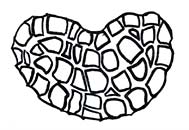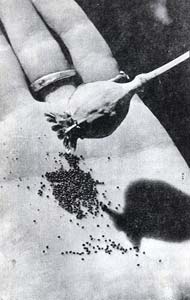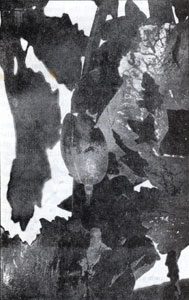Opium Poppy Cultivation, by John W. Allen
 Opium poppy seeds are the only part of the plant that contain no morphine or other narcotics and are therefore legal to possess at the time of this writing. [Erowid Note: We believe that poppy seeds do indeed contain both morphine and codeine, although in small amounts.]
Opium poppy seeds are the only part of the plant that contain no morphine or other narcotics and are therefore legal to possess at the time of this writing. [Erowid Note: We believe that poppy seeds do indeed contain both morphine and codeine, although in small amounts.] They are illegal to plant or grow in the U.S.A. or Canada. The method for cultivation in the parts of the world where opium poppy cultivation is legal is given in the following pages.
 The seeds should be planted directly into the ground. Germination outside of the soil, suck as in damp paper towels is not recommended since the delicate root hairs will be broken off when transferring the seedling to the soil. Autumn is the best time for planting, unless you live in an extreme northern climate where the cold would kill the seedlings. They can survive a certain amount of cold, especially if they are protected by a layer of snow. However, if you are planning to grow your plants in an area where sub zero winter temperatures are the norm, you would be advised to plant in the spring. If planted in March or April, the plants will mature several weeks later and will not be as potent as poppies sown in the fall would be. In colder climates, the plants may be started indoors and transplanted outside in the spring. There will be more information later in this book about indoor cultivation.
The seeds should be planted directly into the ground. Germination outside of the soil, suck as in damp paper towels is not recommended since the delicate root hairs will be broken off when transferring the seedling to the soil. Autumn is the best time for planting, unless you live in an extreme northern climate where the cold would kill the seedlings. They can survive a certain amount of cold, especially if they are protected by a layer of snow. However, if you are planning to grow your plants in an area where sub zero winter temperatures are the norm, you would be advised to plant in the spring. If planted in March or April, the plants will mature several weeks later and will not be as potent as poppies sown in the fall would be. In colder climates, the plants may be started indoors and transplanted outside in the spring. There will be more information later in this book about indoor cultivation. Another possibility is to plant a fall crop and replant again in the spring. This will allow you to replace any plants that have died during the winter.
The best way to plant the seeds is to sprinkle them directly on the soil surface and then cover them with a very thin layer of soil, just a few grains will do. While germination is taking place, the soil should be kept very moist. Germination is rapid and within a week, the seedlings will be up. The surface of the soil should be allowed to dry out somewhat after the seedlings appear, as these young poppies are very prone to stem rot if subjected to excess moisture. Sterilized soil should be used to help prevent not only stem rot, but many other soil born insects and disease.
 Keep the soil surface dry, but don't let your poppies die of thirst, until the secondary leaves have developed. At this point, the critical time is over and the plants become very hardy with age. After a few sets of leaves are produced, the plant may fall over. Don't worry as this is normal and the plant will start growing upward from this position. The plants should be thinned out so that there is about six inches between them. Carefully dig the plants up and transplant them to produce the correct spacing. Poppies are very sensitive to the transplanting so be sure and take plenty of soil around the roots when moving them.
Keep the soil surface dry, but don't let your poppies die of thirst, until the secondary leaves have developed. At this point, the critical time is over and the plants become very hardy with age. After a few sets of leaves are produced, the plant may fall over. Don't worry as this is normal and the plant will start growing upward from this position. The plants should be thinned out so that there is about six inches between them. Carefully dig the plants up and transplant them to produce the correct spacing. Poppies are very sensitive to the transplanting so be sure and take plenty of soil around the roots when moving them.The opium poppy thrives best in a sandy or loamy black soil with a pH of 6 or above, but also does well in lighter soils provided that they are not too acidic. Fertilize with a good neutral pH fertilizer such as Rapid Gro. Most fertilizers that can be used for marijuana are also good for opium poppies. Organic compost may be used as the growing medium, but you must be careful not to let the pH go below 6. Just as do other plants, the poppies will deplete the soil of nutrients, and it is important to replace them with fertilizer. Poppies will survive in poor soil but they will be stunted in size, and their alkaloid content lowered.
Keep the plant well watered until flowering. After the flowers appear, do not water unless absolutely necessary. This is one of the secrets of high opium yield.
© 2000 John W. Allen & Erowid.org


